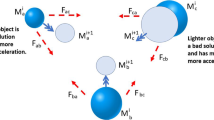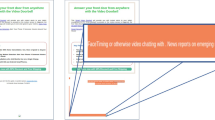Abstract
The e-mail foldering problem is a special classification problem. It concerns a situation where e-mail users create new folders and, at the same time, stop using some of the folders created in the past. Additionally, messages arrive in the system at different time stamps. This article proposes a novel approach to ant colony optimization adapted to data stream analysis. The article is related to the revision of the ant colony optimization algorithm in the e-mail foldering problem and the proposition of a new solution adapted to the data stream. The goal of this work is to allow the classification of messages arriving at the system as data packages; however, due to the large number of decision classes (folders in the inbox), successive packages lead to a large concept drift. To assure the stability of the algorithm, an approach based on the memory being represented as a pheromone trail is introduced. This concept is known from the ant colony optimization methods. At the same time, multiple numbers of classifiers (similar to an ensemble method) are included. The proposed approach was tested on real-world data from the Enron e-mail dataset. An analysis of the two proposed methods related to the data stream was proposed. Both methods were compared with the methods used in the literature. The results achieved, in terms of the accuracy as well as the stability, confirm that (according to a statistical analysis) the proposed solutions are capable of better classifying e-mail messages derived from the system as data packages.




Similar content being viewed by others
References
Babcock B, Babu S, Datar M, Motwani R, Widom J (2002) Models and issues in data stream systems. In: Proceedings of the twenty-first ACM SIGMOD-SIGACT-SIGART symposium on Principles of database systems. ACM, pp 1–16
Bekkerman R, McCallum A, Huang G (2004) Automatic categorization of email into folders: benchmark experiments on Enron and SRI corpora. Center for Intelligent Information Retrieval, Technical Report IR
Boryczka U, Kozak J (2012) Ant colony decision forest meta-ensemble. In: International conference on computational collective intelligence. Springer Berlin Heidelberg, pp 473–482
Boryczka U, Kozak J, Skinderowicz R (2013) Heterarchy in constructing decision trees–parallel ACDT, In: Proceedings of the transactions on computational collective intelligence , vol 10, pp 177–192
Boryczka U, Probierz B, Kozak J (2014) An ant colony optimization algorithm for an automatic categorization of emails. In: 6th international conference computational collective intelligence. Technologies and applications, ICCCI 2014, Seoul, Korea, September 24–26, 2014, pp 583–592
Boryczka U, Probierz B, Kozak J (2015) Adaptive ant colony decision forest in automatic categorization of emails. In: Asian conference on intelligent information and database systems. Springer, pp 451–461
Boryczka U, Probierz B, Kozak J (2016) Automatic categorization of email into folders by ant colony decision tree and social networks. In: Intelligent decision technologies 2016. Springer International Publishing, pp 71–81
Breiman L (1996) Bagging predictors. Mach Learn 24(2):123–140
Breiman L (2001) Random forests. Mach Learn 45:5–32
Brzeziński D, Stefanowski J (2011) Accuracy updated ensemble for data streams with concept drift. In: International conference on hybrid artificial intelligence systems. Springer, Berlin, pp 155–163
Bühlmann P, Hothorn T (2007) Boosting algorithms: regularization, prediction and model fitting. Stat Sci 22(4):477–505
Cheung DW, Wong C, Han J, Ng VT, (1996) Maintenance of discovered association rules in large databases: an incremental updating techniques. In: icde. IEEE, 106
Dorigo M, Birattari M, Stützle T (2006) Ant colony optimization - artificial ants as a computational intelligence technique. IEEE Comput Intell Mag 1:28–39
Dorigo M, Di Caro G, Gambardella LM (1999) Ant algorithms for distributed discrete optimization. Artif Life 5(2):137–172
Dorigo M, Gambardella LM (1997) Ant colony system: a cooperative learning approach to the traveling salesman problem. IEEE Trans Evol Comput 1:53–66
Dorigo M, Stützle T (2004) Ant colony optimization. MIT Press, Cambridge
Fahy C, Yang S (2017) Dynamic stream clustering using ants. In: Advances in computational intelligence systems. Springer, pp 495–508
Fahy C, Yang S, Gongora M (2017) Finding multi-density clusters in non-stationary data streams using an ant colony with adaptive parameters. In: 2017 IEEE congress on evolutionary computation (CEC). IEEE, pp 673–680
Fahy C, Yang S, Gongora M (2018) Ant colony stream clustering: a fast density clustering algorithm for dynamic data streams. IEEE Trans Cybernet 49:2215–2228
Friedman J, Hastie T, Tibshirani R (2000) Additive logistic regression: a statistical view of boosting. Ann Stat 28(2):337–407
Gomes HM, Barddal JP, Enembreck F, Bifet A (2017) A survey on ensemble learning for data stream classification. ACM Comput Surv (CSUR) 50(2):23
Grasse PP (1959) La reconstruction du nid et les coordinations inter-individuelles chez bellicositermes natalensis et cubitermes sp. La theorie de la stigmerie. Insects Soc 6:41–80
Grasse PP (1984) Termitologia, vol II. Masson, Paris
Hulten G, Spencer L, Domingos P (2001) Mining time-changing data streams. In: Proceedings of the seventh ACM SIGKDD international conference on Knowledge discovery and data mining. ACM, pp 97–106
Jiang N, Gruenwald L (2006) Research issues in data stream association rule mining. ACM Sigmod Record 35(1):14–19
Kozak J (2018) Decision tree and ensemble learning based on ant colony optimization. Springer, Berlin
Kozak J, Boryczka U (2013) Dynamic version of the acdt/acdf algorithm for h-bond dataset analysis. In: ICCCI. pp 701–710
Kozak J, Boryczka U (2015) Multiple boosting in the ant colony decision forest meta-classifier. Knowl-Based Syst 75:141–151
Kozak J, Boryczka U (2016) Collective data mining in the ant colony decision tree approach. Inf Sci 372:126–147
Kozak J, Juszczuk P (2017) Association ACDT as a tool for discovering the financial data rules. In: IEEE international conference on innovations in intelligent systems and applications, INISTA 2017, Gdynia, Poland, July 3–5, 2017, pp 241–246
Kozak J, Juszczuk P (2018) The ACDF algorithm in the stream data analysis for the bank telemarketing campaign, IEEE 5th international conference on soft computing and machine intelligence, ISCMI 2018. Nairobi, Kenya, pp 49–53
Lawal IA (2019) Incremental svm learning. In: Learning from data streams in evolving environments. Springer, pp 279–296
Masmoudi N, Azzag H, Lebbah M, Bertelle C, Jemaa MB (2016) Cl-AntInc algorithm for clustering binary data streams using the ants behavior. Procedia Comput Sci 96:187–196
Muthukrishnan S (2005) Data streams: algorithms and applications. Found Trends® Theoret Comput Sci 1(2):117–236
Otero FEB, Freitas AA, Johnson CG (2012) Inducing decision trees with an ant colony optimization algorithm. Appl Soft Comput 12(11):3615–3626
Schapire RE (1990) The strength of weak learnability. Mach Learn 5:197–227
Shetty J, Adibi J (2004) The enron email dataset database schema and brief statistical report. Information sciences institute technical report. Univ South Calif 4(1):120–128
Singh A, Batra S (2018) Ensemble based spam detection in social IoT using probabilistic data structures. Future Gener Comput Syst 81:359–371
Sousa R, Gama J (2018) Multi-label classification from high-speed data streams with adaptive model rules and random rules. In: Progress in artificial intelligence, pp 1–11
Street WN, Kim Y (2001) A streaming ensemble algorithm (sea) for large-scale classification. In: Proceedings of the seventh ACM SIGKDD international conference on Knowledge discovery and data mining. ACM, pp 377–382
Strobl C, Boulesteix AL, Zeileis A, Hothorn T (2007) Bias in random forest variable importance measures: Illustrations, sources and a solution. BMC Bioinform 8(1):25
Stützle T, Hoos H (1997) The MAX–MIN ant system and local search for the traveling salesman problem. In: Baeck, T, Michalewicz Z, Yao X (eds) Proceedings of IEEE–ICEC–EPS’97, IEEE international conference on evolutionary computation and evolutionary programming conference. IEEE Press, pp 309–314
Surjandari I, Dhini A, Rachman A, Novita R (2015) Estimation of dry docking duration using a numerical ant colony decision tree. Int J Appl Manag Sci 7(2):164–175
Wang H, Fan W, Yu PS, Han J (2003) Mining concept-drifting data streams using ensemble classifiers. In: Proceedings of the ninth ACM SIGKDD international conference on Knowledge discovery and data mining. AcM, pp 226–235
Acknowledgements
This paper is co-funded by the National Science Centre, Poland: 2017/01/X/ST6/01477.
Author information
Authors and Affiliations
Corresponding author
Additional information
Publisher's Note
Springer Nature remains neutral with regard to jurisdictional claims in published maps and institutional affiliations.
Rights and permissions
About this article
Cite this article
Kozak, J., Juszczuk, P. & Probierz, B. The hybrid ant colony optimization and ensemble method for solving the data stream e-mail foldering problem. Neural Comput & Applic 32, 15429–15443 (2020). https://doi.org/10.1007/s00521-019-04672-1
Received:
Accepted:
Published:
Issue Date:
DOI: https://doi.org/10.1007/s00521-019-04672-1




